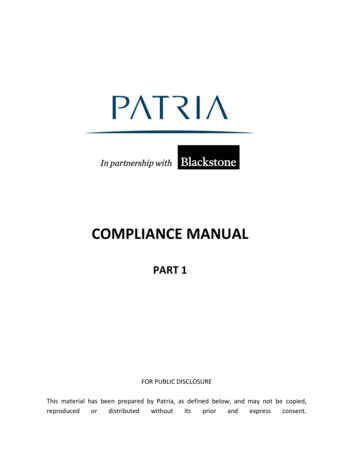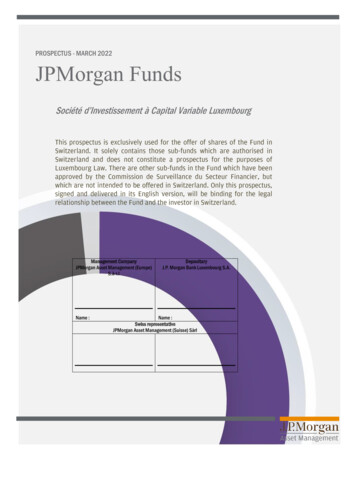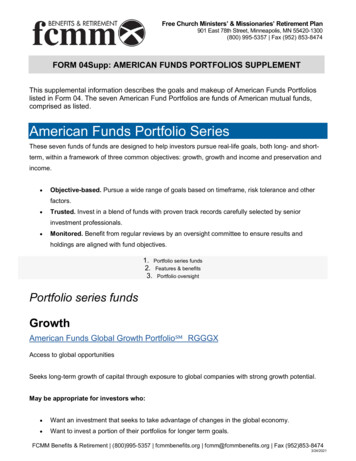
Transcription
Financing forFunds andManagers New NewJanuary2017York CityJanuary17,17,2017York City
Omoz OsayimwesePartnerNew York Office 1 ment ManagementHedge FundsPrivate EquityOmoz focuses his practice on the representation of sponsors and investorsin the formation and structuring of private equity funds, hedge funds andhybrid funds. He also advises investment managers on strategic transactionsinvolving alternative asset management businesses. Omoz has extensiveexperience representing sponsors and investors on funds employing credit,distressed investment, buyout, real estate, special opportunities, structuredproducts, activist, multi-strategy and quantitative strategies. Omoz hasadvised clients on spin-out transactions, acquisitions of minority stakes inhedge fund and private equity firms, joint ventures between investmentmanagement firms and strategic transactions involving a change ofmanagement of private investment funds. He also represents hedge fundmanagers and investors in the negotiation of seed-capital transactions,and advises sponsors of private equity firms and hedge fund firms in thestructuring of complex carry-sharing arrangements among principals andemployees. Omoz’s recent representations include institutional sponsorsand boutique firms in the formation of private equity funds, hedge fundsand hybrid funds; lead investors on their investments in private equity funds;hedge fund managers and investors in seed-capital arrangements;investment managers in joint venture arrangements; and investmentmanagers and investors in the formation of special purpose acquisition andco-investment vehicles.Omoz is recognized as a leading lawyer by The Legal 500 United States.Omoz speaks regularly to investment managers about current developmentsrelating to private investment funds. He is a contributor to the Fund Formationand Incentives Report (Private Equity International in association with SRZ)and was recently featured in the article “Ringing the Changes,” published inPrivate Funds Management.Omoz received his J.D. from University of Michigan Law School and his B.A.,with highest honors, from Michigan State University.26th Annual Private Investment Funds Seminar 2017 Schulte Roth & Zabel LLP
Daniel V. OshinskyPartnerNew York Office 1 eStructured Finance& DerivativesDan represents hedge funds, private equity funds, asset managers, specialtyfinance companies and investment banks in a wide range of financingtransactions. He has particular expertise in liquidity facilities, such as CLOs,warehouse lines, leveraged finance vehicles, capital call facilities and fundof-fund loans. Dan’s practice also encompasses a variety of other securedand unsecured finance transactions, both on the borrower and lender side,including cash-flow and asset-based loans, acquisition financing, Term Bloans, unitranche loans, workout and restructuring transactions, cross-bordertransactions and other complex credit arrangements.Recognized as leader in his field by The Legal 500 United States and NewYork Super Lawyers, he co-authored Hedge Funds: Formation, Operation andRegulation (ALM Law Journal Press) and has spoken on topics that includeinvesting in corporate credit and leverage for investment funds.He received his B.A., magna cum laude, from Yeshiva University and his J.D.from New York University School of Law.Securities & Capital Markets26th Annual Private Investment Funds Seminar 2017 Schulte Roth & Zabel LLP
Eliot L. RellesPartnerNew York Office 1 iot focuses his practice on commercial and corporate finance transactionsand, primarily, the representation of hedge funds, private equity funds,commercial finance companies and investment banks in domestic andcross-border secured and unsecured finance transactions, includingasset-based and cash flow financings, acquisition and leveraged buyoutfinancings, subordinated and mezzanine financings, first-out/last-out, secondlien and tranche B financings, and debtor-in-possession and exit financings.He also counsels clients in debt restructuring and general corporate financematters, and has represented clients in connection with commercial loansecuritizations and capital commitment lines of credit.Recognized by New York Super Lawyers as a leading finance lawyer,Eliot has spoken on topics of interest to the investment managementcommunity, including on distressed investing in the retail industry anddividend recapitalizations.Eliot received his J.D. from Hofstra University School of Law, where he wasassociate editor of the Hofstra University Law Review, and his B.A. from theUniversity of Michigan.26th Annual Private Investment Funds Seminar 2017 Schulte Roth & Zabel LLP
Craig SteinPartnerNew York Office 1 212.756.2390craig.stein@srz.comPracticesStructured Finance& DerivativesRegulatory & ComplianceTrading AgreementsCraig co-heads Schulte Roth & Zabel’s Structured Finance & DerivativesGroup. His practice focuses on swaps and other derivative products, includingcredit- and fund-linked derivatives, prime brokerage and customer tradingagreements, and structured finance and asset-backed transactions. Herepresents issuers, underwriters, collateral managers and portfolio purchasersin public and private structured financings, including collateralized loanobligations (CLOs).Chambers USA has noted that satisfied clients have praised Craig for his “verybroad knowledge of the markets” and for being “incredibly responsive andhelpful in thinking through issues” and “very thoughtful about the market.”Chambers also notes, “He is known for his work in derivative products,representing issuers, underwriters and portfolio purchasers in CLOs. Peers findhis work in structured products and derivatives impressive.” The Legal 500United States has noted that Craig is “recognized for his thought leadershipon regulatory issues affecting both the securitization and derivativesmarkets.” He is also recognized as a leader in his field by Chambers Global andExpert Guide to the World’s Leading Banking, Finance and Transactional LawLawyers (Structured Finance and Securitization). Craig is a member of theAmerican Bar Association, the New York City Bar Association, the New YorkState Bar Association, the Loan Syndications and Trading Association, theInternational Swaps and Derivatives Association and the Structured FinanceIndustry Group. He is a much sought-after speaker for hedge fund industryconferences and webinars and the author of numerous articles on advancedfinancial products. He recently authored “U.S. CLOs: Past and Present,”published in The Journal of Structured Finance, and is co-author of “CLOs andRisk Retention in the U.S. and EU: Complying with the Rules,” published in TheInternational Comparative Legal Guide to: Securitisation 2016. He spoke onhow alternative asset managers and banks work together post-Basel III and onthe latest trading-related compliance and enforcement concerns.Craig earned his J.D., cum laude, from the University of Pennsylvania LawSchool and his undergraduate degree, cum laude, from Colgate University.26th Annual Private Investment Funds Seminar 2017 Schulte Roth & Zabel LLP
Financing for Funds and ManagersI.Warehouse FacilitiesA. Creation and Purpose of Warehouse FacilitiesB.1.A warehouse facility can be used to finance the purchase and origination of a variety of commercialloans and many other asset classes.2.Warehouse facilities may provide short-term financings and are often used to “ramp-up” to a CLO. Ifthe warehouse will terminate upon the closing of a CLO, the warehouse SPV can be used as the CLOvehicle, and the fund manager avoids having to transfer assets from one vehicle into a new vehicleat CLO closing. A warehouse facility may also be a permanent facility for the fund, although an exitto a CLO is still feasible, and is often contemplated in an exception to a facility’s sale restrictions.However, in that case, assets will have to be transferred from the warehouse vehicle into the CLOissuer.3.To create a warehouse facility, a fund forms a special purpose vehicle (SPV), contributes an initialpool of assets (which could include cash) to the SPV, and then uses its equity and third-partyfinancing to expand the pool.Structuring Warehouse Facilities1.The borrower/SPV is designed to be bankruptcy remote. Several features that are built into theorganizational documents of the borrower that support the bankruptcy remoteness of thesubsidiary include:(a)An independent director or manager whose consent is needed for a bankruptcy filing or othermaterial action;(b)“Separateness provisions” that require the borrower to maintain separate books and records,and a separate identity from affiliates; and(c)Limited purpose provisions to limit the scope of creditors.2.As a result of In re Gen. Growth Props., 409 B.R. 43, 71 (Bankr. S.D.N.Y. 2009) (secured lenderssought dismissal of special purpose entity Chapter 11 cases arguing that surreptitious dismissal ofindependent directors on the eve of bankruptcy constituted “bad faith filings”; bankruptcy courtdenied motions to dismiss because, among other things, “corporate documents did not prohibit thisaction or purport to interfere with the rights of a shareholder to appoint independent directors tothe Board.”), lenders will require that organizational documents of the SPV limit independentdirectors to employees of recognized securitization service providers and only allow replacement ofan independent director “for cause.”3.Warehouses may be highly structured facilities, with many elements of a CLO, such as:(a)SPV borrower;(b)Collateral quality and coverage tests;(c)Priority of payment waterfalls; and26th Annual Private Investment Funds Seminar 1 2017 Schulte Roth & Zabel LLP
(d)4.Warehouse facilities incorporate a predetermined list of eligibility criteria and concentration limitsfor the SPV’s assets, which are generally formulated based on a target asset pool and the lender’scredit parameters. Some lenders insist on retaining an approval right for each asset added to thewarehouse and, therefore, under such facilities, the lender is only quasi-committed.5.Other ways warehouses remain distinct from capital markets deals include:6.7.II.Debt under the warehouse facility may be rated, and the lender may require the underlyingloans to be shadow rated, as in a CLO. However, it’s rare to have multiple tranches of debt,and typically the lender group is small. Many warehouse facilities in fact do not have rateddebt.(a)Documentation under a credit agreement or using a total return swap (TRS) instead of a bondindenture;(b)“Club deals” with a limited number of finance providers;(c)More likely to be a U.S.-based issuer instead of Cayman-based; and(d)Administrative agent plays active role in approving portfolio and actions by the collateralmanager.Other features of a warehouse:(a)Assets are held in an SPV owned by the fund (and not “warehoused” on the books of aninvestment bank, which was common before the credit crisis).(b)Facilities may have longer revolving periods (as long as three years) followed by anamortization period.(c)Recourse is limited to the asset pool. Hedge fund sponsors typically are not required toguaranty repayment of the warehouse debt, even if a planned CLO fails to launch.Risk Retention(a)U.S. risk retention rules became effective for CLOs on Dec. 24, 2016. Whether a warehousefacility is subject to the risk retention rules can be a complicated analysis and a marketconsensus as to the treatment of warehouse facilities under the U.S. rules has not yetdeveloped.(b)European risk retention rules have been in effect for several years. European arrangers ofwarehouse facilities (including their U.S. affiliates) have generally taken the view thatwarehouse facilities are subject to the European risk retention rules.Leveraging Commitments and Employee Capital; Other Credit FacilitiesA. Capital Call Lines and Subscription Facilities1.General(a)These facilities are typically used to bridge an investment to be made by a private equity fundprior to receipt of proceeds of capital calls and also occasionally to fund working capital needsof a private equity fund (e.g., to pay fund expenses, including management fees). They are26th Annual Private Investment Funds Seminar 2 2017 Schulte Roth & Zabel LLP
also increasingly being used as more conventional longer-term financing for investments. Asubscription facility may also be used to provide standby letters of credit. In certain types offacilities, drawdowns are required to be repaid within a short period (e.g., between 90 daysand 180 days). This may be required to meet tax structuring needs (such as where the fundhas UBTI-sensitive investors) or may be a credit criteria imposed by the lender. In other cases,drawdowns will not be required to be repaid until final maturity.(b)2.Typically, a security interest on portfolio assets is not taken; instead, the fund’s general partnerpledges its right to call capital from commitments to the lender, and limited partners agree(usually pursuant to the partnership agreement of the fund and sometimes through theexecution of separate confirmation letters) that their unfunded capital commitments can becalled directly by a lender to repay amounts drawn under the facility. Thus, the loan facility issecured by unfunded capital commitments of the limited partners (as well as the collectionaccount for capital contributions). Occasionally, in situations where the fund is near the end ofits investment period and unfunded capital is relatively low, the lender may also take a securityinterest in fund assets.Obligations of Limited PartnersLimited partners are usually required under the fund’s partnership agreement to provide financialinformation about themselves so that the lender can assess individual limited partners’ credit. Somelimited partners (e.g., certain pension funds or foundations) enter into side letters with a fundpursuant to which they agree only to provide publicly available financial information aboutthemselves. In addition, certain tax-exempt limited partners who want minimal UBTI risk will enterinto side letters with the fund that provide that they will be given the chance to pre-fund (usually onnotice shorter than the notice required for capital calls) their share of any drawdown from asubscription facility and such limited partners usually also request that no portion of the interestexpense charged on the fund’s drawdown from the subscription facility will be allocable to a limitedpartner that has pre-funded its share of such drawdown from the subscription facility. Private equityfunds also frequently agree with limited partners to side letter provisions that limit the subscriptionfacility documentation required by a lender to be executed by such limited partners to “customary”documentation and/or documentation “reasonably satisfactory” to such limited partners.3.Terms of Borrowing(a)The borrowing base (i.e., the amount of funds that can be drawn down under a subscriptionfacility) is typically equal to a percentage of the unfunded capital commitments of eligible (or“included”) limited partners. Limited partners that do not provide sufficient financialinformation about themselves, or whose credit the lender deems insufficient, are typicallyexcluded from the borrowing base. The default or bankruptcy of a single eligible limitedpartner should not result in default if outstanding loans are less than the amount of borrowingbase. However, if the facility is provided to a “fund of one,” a default or bankruptcy eventaffecting the investor would result in all loans becoming due and an inability to borrow goingforward, because the borrowing base will be zero. Note that, even though some investors arenot included in the borrowing base because the lender is not sufficiently satisfied with theircreditworthiness, the GP would still be pledging its right to call capital from such investors.(b)The advance rate on drawdowns may be a blended rate that takes into account differentadvance rates for different limited partners in the borrowing base (e.g., limited partners withhigher ratings effectively get to borrow a higher percentage of their collateral). In addition tointerest on amounts drawn down from the subscription facility, lenders may also charge afacility fee payable at closing, as well as an unused commitment fee.26th Annual Private Investment Funds Seminar 3 2017 Schulte Roth & Zabel LLP
(c)4.B.Because lenders are primarily relying on the capital commitments, rather than on the value ofthe borrower’s assets, a subscription facility should include fewer restrictions and controlsover a fund’s business (which restrictions and controls may be typical in a more typicalcorporate credit facility). A subscription facility, however, will include many provisions relatingto the investors (such as restrictions on transfers and withdrawals by investors or excusing aninvestor’s obligation to fund, limitations on who may become an investor and restrictions onamendments to the partnership agreement or entering into new side letters). Usually, therestrictions are tighter for the investors included in the borrowing base, although since allinvestor commitments are pledged, the lender may still insist on some control over certainactions relating to excluded investors.Other Advantages to Using Subscription Facilities; Longer-term Facilities(a)Sometimes, funds prefer to draw down funds under a subscription facility rather than callcapital directly from the fund’s investors because, in many instances, the preferred return onan investor’s capital contribution to a fund only starts ticking when the capital contribution isactually made. If the interest rate at which the fund can borrow from a lender is low comparedto the preferred return rate, managers may prefer to keep money drawn down by a fundunder a subscription line facility outstanding (and unpaid) for a longer period of time thanwould otherwise be the case.(b)The effective interest rate charged on borrowings under a subscription line facility is, in part,based on the creditworthiness of institutional investors who may be investors in the fund.Some of the large institutional investors in private equity funds have very good credit ratingsand because of these good credit ratings, it may therefore be possible for a subscription linefacility to charge a lower interest rate than would be available for a borrowing to finance fundinvestments where such investments are pledged as collateral for the lender. A consequenceof the foregoing is that some funds are using longer-term capital call lines, particularly whenthe fund has no UBTI-sensitive investors, in lieu of more traditional asset-based borrowing bythe fund.Leveraged Co-investment Arrangements1.General(a)Investors in private equity funds usually want the fund’s investment team to be aligned withinvestors by having “skin in the game” and will, therefore, often require investment teammembers (either individually or collectively) to make capital commitments to the privateequity fund. A manager may also want the investment team for a particular fund to participatein the fund’s P&L through an actual investment (i.e., capital commitment) in the fund.(b)Leveraged co-investment arrangements provide a means for a manager to facilitate loansfrom a lender to the employees and principals of a private equity fund manager to fund capitalcommitments to be made by such employees and principals to a private equity fund.Managers with sufficient internal capital may loan money to employees to fund employees’capital commitments under a similar arrangement. More typically, a manager will arrange for alender to provide loans to employees to make capital commitments. Private banks and theprivate banking units of larger banks are typically the types of lenders who offer leveraged coinvestment arrangements.26th Annual Private Investment Funds Seminar 4 2017 Schulte Roth & Zabel LLP
2.Terms of BorrowingLoan advances are typically made each time the private equity fund makes a capital call and anemployee’s partnership interest in the private equity fund is usually pledged as collateral to themanager, who then guarantees repayment of the loan to the lender. The manager, in turn, thentypically pledges to the lender its right to receive management fees. A more manager-friendlyoption is for the employees to pledge their interest in the private equity fund directly to the lender.Proceeds from any distribution (other than distributions subject to reinvestment) are usually paiddirectly to the lender to repay principal on the loan and the lender often requires employeesparticipating in the leveraged co-investment to maintain bank accounts with the lender.3.Structure(a)Instead of having employees invest directly in the fund, sometimes the manager will establishsolely for employees:(i)A parallel fund in which the loan advances will be invested, which parallel fund will investalongside the main private equity fund; or(ii) A feeder fund in which loan advances will be invested and which will, in turn, investsubstantially all of its capital into the main private equity fund.(b)4.The parallel fund option may not necessarily be economically efficient since it wouldnecessitate allocating investments across funds, which entails additional operational costs thatare not incurred with a feeder fund structure.Regulatory RequirementsFor securities law purposes employees will need to be accredited investors under Regulation D, andsince many private equity funds rely on the Section 3(c)(7) exemption to the Investment CompanyAct, employees also typically need to be “qualified purchasers” or “knowledgeable employees.”C.Management Company Facilities1.Management companies sometimes borrow money from lenders in order to meet their workingcapital needs, which may include paying employee salaries and bonuses. In some instances, themanager/GP of a fund may have significant unrealized carried interest or incentive allocations in thefund which, upon realization, could help pay employee compensation. In such instances, it may beinconvenient or impractical to sell investments in order to have cash to pay compensation and themanager may instead choose to borrow funds to compensate employees.2.Management company borrowings are usually secured by granting the lender a security interest inmanagement fees. This kind of secured borrowing by the management company can createconcerns for investors who may be worried that if the management company defaulted on suchborrowings and the lender started receiving the management fees that the management companywould otherwise have been entitled to receive, then the management company would not be ableto cover its ordinary operating expenses (e.g., salaries, rent, utilities, etc.) and perform its corefunction as investment adviser to the applicable fund. This is one reason why management companyborrowings are often for relatively small amounts.26th Annual Private Investment Funds Seminar 5 2017 Schulte Roth & Zabel LLP
III. Master Repurchase AgreementsA. Basic Terms of RepoB.1.Under a repo, the fund sells assets to the repo counterparty for cash with an agreement by the fundto repurchase the assets at the end of the term. During the term of the trade, the fund will pay afinancing fee to the counterparty, known as the price differential in repo parlance. Cash flows on theasset get paid by the counterparty to the fund (net of the price differential) during the term of thetrade.2.Market-value financing: Repos are typically market-value financing arrangements whereby the fundwill be required to deliver margin or collateral if the market value of the asset declines. Butdepending on asset and business deal, they don’t have to be.3.Complex repos are documented under non-standard negotiated agreements similar to traditionalasset-based credit agreement financings (as opposed to industry standard MRA and GMRA fortreasuries).4.Custodial arrangements: Many repos have assets deposited with a custodian, thereby protecting thefund against dealer credit risk. If there is no custodian, the dealer has the right to rehypothecate theassets; but are still required to sell back the assets at termination.Legal Considerations1.Master repurchase agreements receive special treatment under the U.S. Bankruptcy Code. There aresafe harbor provisions that allow a counterparty to liquidate, terminate and accelerate a contractoutside of the automatic stay provisions of the Bankruptcy Code.2.Safe harbor bankruptcy for repurchase agreements and securities contracts:3.(a)Section 555 of the Bankruptcy Code — contractual right to liquidate, terminate or accelerate asecurities contract;(b)Section 559 of the Bankruptcy Code — contractual right to liquidate, terminate or accelerate arepurchase agreement;(c)Section 561 of the Bankruptcy Code — contractual right to terminate, liquidate, accelerate oroffset under a master netting agreement and across contracts; proceedings under Chapter 15;and(d)Section 362(b)(6) of the Bankruptcy Code — contractual rights, including right to offset or netout any termination value, payment amount, or other transfer obligation, under any securityagreement or arrangement or other credit enhancement forming a part of or related to anycommodity contract, forward contract or securities contract.Section 101(47) of the Bankruptcy Code — Definition of “Repurchase Agreement”The term “repurchase agreement” (which definition also applies to a reverse repurchase agreement)(a)Means:(i)An agreement, including related terms, which provides for the transfer of one or morecertificates of deposit, mortgage related securities (as defined in Section 3 of the26th Annual Private Investment Funds Seminar 6 2017 Schulte Roth & Zabel LLP
Securities Exchange Act of 1934), mortgage loans, interests in mortgage-relatedsecurities or mortgage loans, eligible bankers’ acceptances, qualified foreign governmentsecurities (defined as a security that is a direct obligation of, or that is fully guaranteedby, the central government of a member of the Organization for Economic Cooperationand Development) or securities that are direct obligations of, or that are fully guaranteedby, the United States or any agency of the United States against the transfer of funds bythe transferee of such certificates of deposit, eligible bankers’ acceptances, securities,mortgage loans, or interests, with a simultaneous agreement by such transferee totransfer to the transferor thereof certificates of deposit, eligible bankers’ acceptance,securities, mortgage loans, or interests of the kind described in this clause, at a datecertain not later than one year after such transfer or on demand, against the transfer offunds;(ii) Any combination of agreements or transactions referred to in clauses (1) and (3);(iii) An option to enter into an agreement or transaction referred to in clause (1) or (2);(iv) A master agreement that provides for an agreement or transaction referred to in clause(1), (2) or (3), together with all supplements to any such master agreement, withoutregard to whether such master agreement provides for an agreement or transaction thatis not a repurchase agreement under this paragraph, except that such master agreementshall be considered to be a repurchase agreement under this paragraph only with respectto each agreement or transaction under the master agreement that is referred to in clause(1), (2) or (3); or(v) Any security agreement or arrangement or other credit enhancement related to anyagreement or transaction referred to in clause (1), (2), (3) or (4), including any guaranteeor reimbursement obligation by or to a repo participant or financial participant inconnection with any agreement or transaction referred to in any such clause, but not toexceed the damages in connection with any such agreement or transaction, measured inaccordance with Section 562 of this title; and(b)4.Does not include a repurchase obligation under a participation in a commercial mortgage loan.Section 741 of the Bankruptcy Code — Definition of “Securities Contract”“Securities contract”(a)Means:(i)A contract for the purchase, sale or loan of a security, a certificate of deposit, a mortgageloan, any interest in a mortgage loan, a group or index of securities, certificates ofdeposit, or mortgage loans or interests therein (including an interest therein or based onthe value thereof), or option on any of the foregoing, including an option to purchase orsell any such security, certificate of deposit, mortgage loan, interest, group or index, oroption, and including any repurchase or reverse repurchase transaction on any suchsecurity, certificate of deposit, mortgage loan, interest, group or index, or option(whether or not such repurchase or reverse repurchase transaction is a “repurchaseagreement,” as defined in Section 101);(ii) Any option entered into on a national securities exchange relating to foreign currencies;26th Annual Private Investment Funds Seminar 7 2017 Schulte Roth & Zabel LLP
(iii) The guarantee (including by novation) by or to any securities clearing agency of asettlement of cash, securities, certificates of deposit, mortgage loans or interests therein,group or index of securities, or mortgage loans or interests therein (including any interesttherein or based on the value thereof), or option on any of the foregoing, including anoption to purchase or sell any such security, certificate of deposit, mortgage loan,interest, group or index, or option (whether or not such settlement is in connection withany agreement or transaction referred to in clauses (1) through (11));(iv) Any margin loan;(v) Any extension of credit for the clearance or settlement of securities transactions;(vi) Any loan transaction coupled
hedge fund managers and investors in seed-capital arrangements; investment managers in joint venture arrangements; and investment managers and investors in the formation of special purpose acquisition and co-investment vehicles. Omoz is recognized as a leading lawyer by The Legal 500 United States.










